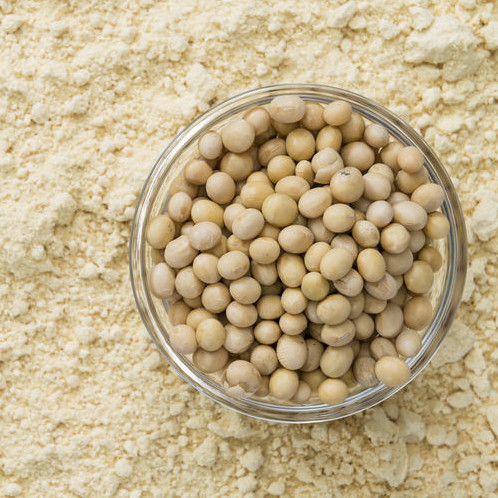Soy
Also known as soybean
What is Soy?
Soy or soybeans are a legume crop and an important source of oil, protein, fiber and flour. In fact, they are the largest single source of edible oil worldwide, accounting for 50% of the world’s supply.1
Various components of the soybean can be used in bakery products including:
- Flour
- Fiber
- Oil and protein (concentrates and isolates)
- Milk
- Gluten-free breads
- Egg-replacement in cakes
Origin
The plant was thought to have originated in East Asia and became a cultivated crop in Japan and Korea about 2,000 years ago.1 Currently, the United States and Brazil are the largest producers.
It first found use in the baking industry during World War II when soy flour was substituted for nonfat dry milk in recipes.2 Since that time, the soy industry has developed a wide range of products for use in the baking industry.
Function
Various fractions of the bean are used in baking. Flours are available commercially with various amounts of fat and also as lecithinated. The primary reason to use soy proteins in baked goods is to increase protein content.
Soy proteins are known for their ability to bind high amounts of water, to gel and to improve the overall consistency and texture of baked products.
Composition of Select Soy Products:3
| Product | Protein (%) | Fat (%) | Moisture (%) |
| Flour & Grits | |||
| Full Fat | 41.0 | 20.5 | 5.8 |
| High Fat | 46.0 | 14.5 | 6.0 |
| Low Fat | 52.5 | 4.0 | 6.0 |
| Defatted | 53.0 | 0.6 | 6.0 |
| Lecithinated | 51.0 | 6.5 | 7.0 |
| Protein concentrates | 66.2 | 0.3 | 6.7 |
| Protein isolates | 92.8 | <0.1 | 4.7 |
Nutrition
Soy is the only vegetable that contains all the essential amino acids in adequate amounts, is a complete protein and unlike wheat, has a high lysine content and is rich in fats, vitamins and minerals.3
Soy-based products contain high levels of isoflavones and other health-promoting components associated with reduced risk of cardiovascular diseases and some cancers as well as bone-health improvement.
Commercial production
Soybean meal (approximately 50% protein) is what remains after the oil is either pressed or extracted from the bean. Soymeal can be further processed into:1
- Soybean flour (approximately 50% protein): Remains when meal is ground to defatted soybean flour and fat or lecithin is added back as desired.
- Soy concentrates (approximately 70% protein): Remain when meal is extracted with a solvent (alcohols) to remove carbohydrates and produce a concentrate with a bland flavor.
- Soy isolates (approximately 95% protein): Remain when meal is put through an alkaline extraction selective solubilization process to produce highly functional isolates.
Application
There are advantages to using 2-5% soy flour in baked items.2 Bread dough formulated with soy-fortified flour will have increased water absorption, less mixing time and decreased fermentation time.
Cakes that utilize soy flour as a replacement for non-fat milk solids are more tender and have a better texture. While doughnuts formulated with 3-3.5% soy have reduced oil pickup and a good crust color.
Depending on the method of process, though, this flour can have an off flavor and be a limiting factor for use in baked goods.
FDA regulations
In 1999, the FDA authorized the use of a health claim label linking soy protein consumption with the reduced risk of coronary heart disease.4 The Nutrition Labeling and Education Act (NLEA) of 1990 directed FDA to issue regulations providing for the use of health claims linking a food or food component with the reduced risk of disease or health condition. There have been only twelve claims reviewed and approved by FDA since inception.
Additionally, soy is one of the eight major food allergens requiring labeling as specified by FDA guidelines.
References
- Berk, Z. “The Soybean”, Technology of Production of Edible Flours and Protein Products from Soybeans, FAO Service Bulletin 97,1992, Rome.
- Hoover, W. Use of Soy in Bakery Products, Journal of the American Oil Chemists’ Society, 52.4.1975: 267A-269A.
- Pyler, E.J. and Gorton L.A. “Bakery Ingredients”. Baking Science and Technology, 4th Edition, Sosland Publishing, 2008, pp 171-174.
- Food and Drug Administration HHS. “Food Labeling: Health Claims; Soy Protein and Coronary Heart Disease”, Federal Register, 64:206, pp 57700, October 26, 1999.


